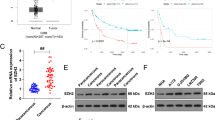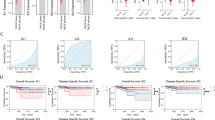Abstract
MicroRNA-29a (miR-29a) has been reported to play important roles in tumor initiation, development, and metastasis in various cancers. However, the biological function and potential mechanisms of miR-29a in papillary thyroid carcinoma (PTC) remain unclear. In the present study, we discovered that miR-29a was frequently downregulated in PTC tissues, and its expression was significantly associated with tumor size, TNM stage, and lymph node metastasis. Functional assays showed that overexpression of miR-29a markedly suppressed PTC cell proliferation, migration, and invasion and promoted PTC apoptosis and cell cycle arrest at G0/G1 phase. In vivo, miR-29a overexpression decreased tumor growth in a xenograft mouse model. Luciferase reporter assay showed that miR-29a can directly bind to the 3′ untranslated region (UTR) of AKT3 in PTC cells. Overexpreesion of miR‑29a obviously decreased AKT3 expression, thereby suppressing phosphatidylinositol 3-kinase (PI3K)/AKT pathway activation. We also confirmed that AKT3 expression was increased in PTC tissue and was inversely correlated miR-29a expression in PTC tissues. In addition, downregulation of AKT3 by siRNA mimicked the effects of miR-29a overexpression, and upregulation of AKT3 partially reversed the inhibitory effects of miR-29a. These results suggested that miR-29a could act as a tumor suppressor in PTC by targeting AKT3 and that miR-29a may potentially serve as an anti-tumor agent in the treatment of PTC.








Similar content being viewed by others
References
Brown RL, de Souza JA, Cohen EE. Thyroid cancer: burden of illness and management of disease. J Cancer. 2011;2:193–9.
Pitoia F, Bueno F, Urciuoli C, Abelleira E, Cross G, Tuttle RM. Outcomes of patients with differentiated thyroid cancer risk-stratified according to the American thyroid association and Latin American thyroid society risk of recurrence classification systems. Thyroid Off J Am Thyroid Assoc. 2013;23:1401–7.
Grant CS. Recurrence of papillary thyroid cancer after optimized surgery. Gland Surg. 2015;4:52–62.
Brennecke J, Cohen SM. Towards a complete description of the microrna complement of animal genomes. Genome Biol. 2003;4:228.
Ambros V. The functions of animal micrornas. Nature. 2004;431:350–5.
Bartel DP. Micrornas: genomics, biogenesis, mechanism, and function. Cell. 2004;116:281–97.
Carthew RW, Sontheimer EJ. Origins and mechanisms of mirnas and sirnas. Cell. 2009;136:642–55.
Esquela-Kerscher A, Slack FJ. Oncomirs - micrornas with a role in cancer. Nat Rev Cancer. 2006;6:259–69.
Lu J, Getz G, Miska EA, Alvarez-Saavedra E, Lamb J, Peck D. Microrna expression profiles classify human cancers. Nature. 2005;435:834–8.
Volinia S, Calin GA, Liu CG, Ambs S, Cimmino A, Petrocca F, et al. A microrna expression signature of human solid tumors defines cancer gene targets. Proc Natl Acad Sci U S A. 2006;103:2257–61.
Wang Y, Zhang X, Li H, Yu J, Ren X. The role of mirna-29 family in cancer. Eur J Cell Biol. 2013;92:123–8.
Cui Y, Su WY, Xing J, Wang YC, Wang P, Chen XY, et al. Mir-29a inhibits cell proliferation and induces cell cycle arrest through the downregulation of p42.3 in human gastric cancer. PLoS One. 2011;6:e25872.
Trehoux S, Lahdaoui F, Delpu Y, Renaud F, Leteurtre E, Torrisani J, et al. Micro-rnas mir-29a and mir-330-5p function as tumor suppressors by targeting the muc1 mucin in pancreatic cancer cells. Biochim Biophys Acta. 1853;2015:2392–403.
Li Y, Kong D, Ahmad A, Bao B, Dyson G, Sarkar FH. Epigenetic deregulation of mir-29a and mir-1256 by isoflavone contributes to the inhibition of prostate cancer cell growth and invasion. Epigenetics. 2012;7:940–9.
Zhong S, Li W, Chen Z, Xu J, Zhao J. Mir-222 and mir-29a contribute to the drug-resistance of breast cancer cells. Gene. 2013;531:8–14.
Qiu F, Sun R, Deng N, Guo T, Cao Y, Yu Y, et al. Mir-29a/b enhances cell migration and invasion in nasopharyngeal carcinoma progression by regulating sparc and col3a1 gene expression. PLoS One. 2015;10:e0120969.
Zhao D, Jiang X, Yao C, Zhang L, Liu H, Xia H, et al. Heat shock protein 47 regulated by mir-29a to enhance glioma tumor growth and invasion. J Neuro-Oncol. 2014;118:39–47.
Zhu C, Wang Y, Kuai W, Sun X, Chen H, Hong Z. Prognostic value of mir-29a expression in pediatric acute myeloid leukemia. Clin Biochem. 2013;46:49–53.
Kang SS, Kwon T, Kwon DY, Do SI. Akt protein kinase enhances human telomerase activity through phosphorylation of telomerase reverse transcriptase subunit. J Biol Chem. 1999;274:13085–90.
de la Chapelle A, Jazdzewski K. Micrornas in thyroid cancer. J Clin Endocrinol Metab. 2011;96:3326–36.
Chiang CH, Hou MF, Hung WC. Up-regulation of mir-182 by beta-catenin in breast cancer increases tumorigenicity and invasiveness by targeting the matrix metalloproteinase inhibitor reck. Biochim Biophys Acta. 1830;2013:3067–76.
Visone R, Russo L, Pallante P, De Martino I, Ferraro A, Leone V, et al. Micrornas (mir)-221 and mir-222, both overexpressed in human thyroid papillary carcinomas, regulate p27kip1 protein levels and cell cycle. Endocr-Relat Cancer. 2007;14:791–8.
Mardente S, Mari E, Consorti F, Di Gioia C, Negri R, Etna M, et al. Hmgb1 induces the overexpression of mir-222 and mir-221 and increases growth and motility in papillary thyroid cancer cells. Oncol Rep. 2012;28:2285–9.
Zhang X, Li M, Zuo K, Li D, Ye M, Ding L, et al. Upregulated mir-155 in papillary thyroid carcinoma promotes tumor growth by targeting apc and activating wnt/beta-catenin signaling. J Clin Endocrinol Metab. 2013;98:E1305–13.
Ma Y, Qin H, Cui Y. Mir-34a targets gas1 to promote cell proliferation and inhibit apoptosis in papillary thyroid carcinoma via pi3k/akt/bad pathway. Biochem Biophys Res Commun. 2013;441:958–63.
Liu L, Wang J, Li X, Ma J, Shi C, Zhu H, et al. Mir-204-5p suppresses cell proliferation by inhibiting igfbp5 in papillary thyroid carcinoma. Biochem Biophys Res Commun. 2015;457:621–6.
Gu L, Sun W. Mir-539 inhibits thyroid cancer cell migration and invasion by directly targeting CARMA1. Biochem Biophys Res Commun. 2015;464: 1128–33.
Guan H, Liang W, Xie Z, Li H, Liu J, Liu L, et al. Down-regulation of mir-144 promotes thyroid cancer cell invasion by targeting zeb1 and zeb2. Endocrine. 2015;48:566–74.
Jiang H, Zhang G, Wu JH, Jiang CP. Diverse roles of mir-29 in cancer (review). Oncol Rep. 2014;31:1509–16.
Amodio N, Rossi M, Raimondi L, Pitari MR, Botta C, Tagliaferri P, et al. Mir-29s: a family of epi-mirnas with therapeutic implications in hematologic malignancies. Oncotarget. 2015;6:12837–61.
Rostas 3rd JW, Pruitt HC, Metge BJ, Mitra A, Bailey SK, Bae S, et al. Microrna-29 negatively regulates emt regulator n-myc interactor in breast cancer. Mol Cancer. 2014;13:200.
Nishikawa R, Goto Y, Kojima S, Enokida H, Chiyomaru T, Kinoshita T, et al. Tumor-suppressive microrna-29s inhibit cancer cell migration and invasion via targeting lamc1 in prostate cancer. Int J Oncol. 2014;45:401–10.
Tan M, Wu J, Cai Y. Suppression of wnt signaling by the mir-29 family is mediated by demethylation of wif-1 in non-small-cell lung cancer. Biochem Biophys Res Commun. 2013;438:673–9.
Hers I, Vincent EE, Tavare JM. Akt signalling in health and disease. Cell Signal. 2011;23:1515–27.
Guo H, German P, Bai S, Barnes S, Guo W, Qi X, et al. The pi3k/akt pathway and renal cell carcinoma. J Genet Genomics = Yi Chuan Xue Bao. 2015;42:343–53.
Xia P, Xu XY. Pi3k/akt/mtor signaling pathway in cancer stem cells: from basic research to clinical application. Am J Cancer Res. 2015;5:1602–9.
Petrulea MS, Plantinga TS, Smit JW, Georgescu CE, Netea-Maier RT. Pi3k/akt/mtor: a promising therapeutic target for non-medullary thyroid carcinoma. Cancer Treat Rev. 2015;41:707–13.
Xing M. Genetic alterations in the phosphatidylinositol-3 kinase/akt pathway in thyroid cancer. Thyroid Off J Am Thyroid Assoc. 2010;20:697–706.
Author information
Authors and Affiliations
Corresponding authors
Ethics declarations
Conflicts of interest
None
Additional information
Guang Chen and Xiaofang Yu contributed equally to this paper.
Rights and permissions
About this article
Cite this article
Li, R., Liu, J., Li, Q. et al. miR-29a suppresses growth and metastasis in papillary thyroid carcinoma by targeting AKT3. Tumor Biol. 37, 3987–3996 (2016). https://doi.org/10.1007/s13277-015-4165-9
Received:
Accepted:
Published:
Issue Date:
DOI: https://doi.org/10.1007/s13277-015-4165-9




